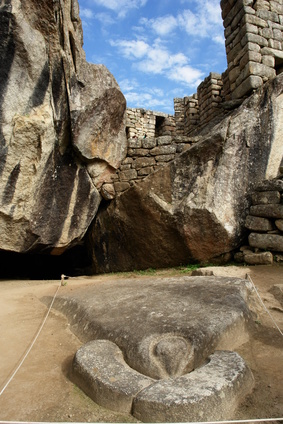The Temple of the Condor
 Extraordinary beauty that resides in Machu Picchu can be seen both in its ruins in the Valley as well as in their wonderful adjoining places that offer the unique flora and fauna of this valley of the Andes located in Machu Picchu and Huayna Picchu mountain systems. The impressive air show that offers one of the indigenous wonders of these places, the Condor, a symbol sacred to the Inca civilization which granted the status of King de los Andes can be seen from any location of Machu Picchu.
Extraordinary beauty that resides in Machu Picchu can be seen both in its ruins in the Valley as well as in their wonderful adjoining places that offer the unique flora and fauna of this valley of the Andes located in Machu Picchu and Huayna Picchu mountain systems. The impressive air show that offers one of the indigenous wonders of these places, the Condor, a symbol sacred to the Inca civilization which granted the status of King de los Andes can be seen from any location of Machu Picchu.
In the sector to the East of the Citadel are the constructions of greater importance for the Inca civilization, buildings which are all oriented to the Sun to facilitate measurements of the stars, sector where the Temple of the Condor, as well as the Temple of the Sun, the Temple of the three Windows, the sacred rock and the residential complex of gardens and patios that served as a monastery for the virgins of the Sun known as Aqllawasi. To the South of the Temple of the Condor, is the residential area of the high Inca social class, which communicates with it through a series of courtyards, which show signs of having been used for the breeding of Guinea Pigs.
The Temple of the Condor has its location in the South East of the urban sector of the Citadel, which has a peculiarity in its architecture to show a series of irregularities in the architecture of the different buildings whose purpose was the melt with the environment, producing a fusion with the profile offered by the rocks of the surrounding area. Many theories of expert anthropologists believe have explained the location of the Temple of the Condor after the discovery of the Rocky massif which presents the shape of a bird with wings extended, fact that gave understanding to the Inca civilization that the settlement designated by their deities for worship and celebration of sacred rituals, because the reflection of this rock to be illuminated by the Sun projects the figure of a bird that was.
But in addition to the rock with bird with spread wings, the studies carried out in the area discovered another representation in stone that resembles the figure of this animal; in this case, this rocky massif was delicately carved to create the bust of the bird, which has come to be regarded as representing the Condor, why what he and the Inca civilization was able to complete the representation of this Idol to their conduct of their offerings in concerning sacred rituals to the Condor. The Inca civilization, the figure of the Condor was divine representation of both production as fertility because the contemporary accounts tell that when the Condor, to move their wings, gathers clouds that would produce rain, the best fertilizer forthe land.
The dungeons of Machu Picchu can be traced in the underground part of the temple. These dungeons were designated to the incarceration of prisoners with the peculiarity that locked them together on wild animals as a method of torture.